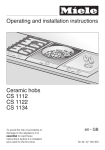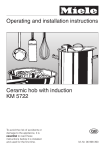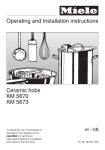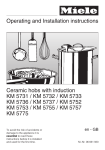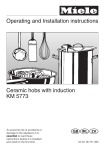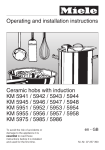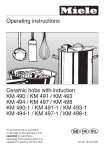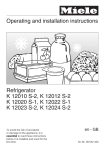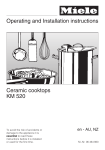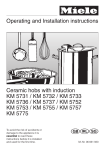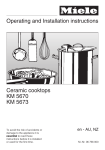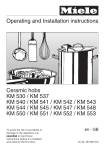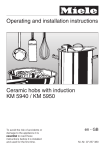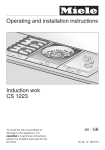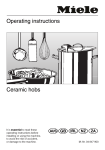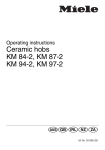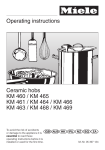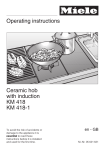Download Operating and Installation instructions Ceramic hobs KM 520
Transcript
Operating and Installation instructions Ceramic hobs KM 520 KM 523 To avoid the risk of accidents or damage to the appliance it is essential to read these instructions before it is installed and used for the first time. en - GB M.-Nr. 06 464 850 Contents Description of the appliace . . . . . . . . . . . . . . . . . . . . . . . . . . . . . . . . . . . . . . . . . . 3 KM 520. . . . . . . . . . . . . . . . . . . . . . . . . . . . . . . . . . . . . . . . . . . . . . . . . . . . . . . . . . . 3 KM 523. . . . . . . . . . . . . . . . . . . . . . . . . . . . . . . . . . . . . . . . . . . . . . . . . . . . . . . . . . . 4 Cooking zones . . . . . . . . . . . . . . . . . . . . . . . . . . . . . . . . . . . . . . . . . . . . . . . . . . . . . 5 Warning and Safety instructions . . . . . . . . . . . . . . . . . . . . . . . . . . . . . . . . . . . . . 6 Caring for the environment . . . . . . . . . . . . . . . . . . . . . . . . . . . . . . . . . . . . . . . . . 12 Before using for the first time. . . . . . . . . . . . . . . . . . . . . . . . . . . . . . . . . . . . . . . 13 How the cooking zones work . . . . . . . . . . . . . . . . . . . . . . . . . . . . . . . . . . . . . . . 14 Operation . . . . . . . . . . . . . . . . . . . . . . . . . . . . . . . . . . . . . . . . . . . . . . . . . . . . . . . 15 Switching on and off . . . . . . . . . . . . . . . . . . . . . . . . . . . . . . . . . . . . . . . . . . . . . . . 15 Residual heat indicators . . . . . . . . . . . . . . . . . . . . . . . . . . . . . . . . . . . . . . . . . . . . 15 Settings . . . . . . . . . . . . . . . . . . . . . . . . . . . . . . . . . . . . . . . . . . . . . . . . . . . . . . . . . 16 Switching on an extended area . . . . . . . . . . . . . . . . . . . . . . . . . . . . . . . . . . . . . . . 17 Pans . . . . . . . . . . . . . . . . . . . . . . . . . . . . . . . . . . . . . . . . . . . . . . . . . . . . . . . . . . . . 18 Tips on saving energy . . . . . . . . . . . . . . . . . . . . . . . . . . . . . . . . . . . . . . . . . . . . . 19 Overheating protection . . . . . . . . . . . . . . . . . . . . . . . . . . . . . . . . . . . . . . . . . . . . . 20 Cleaning and care . . . . . . . . . . . . . . . . . . . . . . . . . . . . . . . . . . . . . . . . . . . . . . . . 21 Problem solving guide . . . . . . . . . . . . . . . . . . . . . . . . . . . . . . . . . . . . . . . . . . . . 23 To test the power level . . . . . . . . . . . . . . . . . . . . . . . . . . . . . . . . . . . . . . . . . . . . 24 Optional accessories . . . . . . . . . . . . . . . . . . . . . . . . . . . . . . . . . . . . . . . . . . . . . . 26 After sales service, data plate . . . . . . . . . . . . . . . . . . . . . . . . . . . . . . . . . . . . . . 27 2 Contents Installation . . . . . . . . . . . . . . . . . . . . . . . . . . . . . . . . . . . . . . . . . . . . . . . . . . . . . . 28 Safety instructions for installation . . . . . . . . . . . . . . . . . . . . . . . . . . . . . . . . . . . . . 28 Building-in dimensions . . . . . . . . . . . . . . . . . . . . . . . . . . . . . . . . . . . . . . . . . . . . . 32 Preparing the worktop . . . . . . . . . . . . . . . . . . . . . . . . . . . . . . . . . . . . . . . . . . . . . . 34 Fixing the spring clamps . . . . . . . . . . . . . . . . . . . . . . . . . . . . . . . . . . . . . . . . . . . . 35 Installing the hob . . . . . . . . . . . . . . . . . . . . . . . . . . . . . . . . . . . . . . . . . . . . . . . . . . 36 Protective shelf . . . . . . . . . . . . . . . . . . . . . . . . . . . . . . . . . . . . . . . . . . . . . . . . . . . 37 Sealant . . . . . . . . . . . . . . . . . . . . . . . . . . . . . . . . . . . . . . . . . . . . . . . . . . . . . . . . . . 37 Electrical connection . . . . . . . . . . . . . . . . . . . . . . . . . . . . . . . . . . . . . . . . . . . . . . . 38 Wiring diagram . . . . . . . . . . . . . . . . . . . . . . . . . . . . . . . . . . . . . . . . . . . . . . . . . . . 40 3 Description of the appliace KM 520 abcd Single circle zones Control for cooking zone f Rear left e Residual heat indicators g Rear right h Front right i Front left 4 Description of the appliace KM 523 a Double circle zone Control for cooking zone bd Single circle zones f Rear left c g Rear right Extended cooking zone h Front right e Residual heat indicators i Front left 5 Description of the appliace Cooking zones Cooking zone KM 520 KM 523 C in cm Rating in watts (230 V) C in cm Rating in watts (230 V) y 14.5 1200 12.0 / 21.0 750 / 2200 w 21.0 2300 14.5 1200 x 14.5 1200 17.0 / 17.0 x 26.5 1500 / 2400 z 18.0 1800 18.0 1800 Total: 6500 6 Total: 7600 Warning and Safety instructions To avoid the risk of accidents and damage to the appliance, please read these instructions carefully before using it for the first time. They contain important notes on its installation, safety, use and maintenance. This appliance is not intended for use by persons (including children) with reduced physical, sensory or metal capabilities, or lack of experience or knowledge, unless they have been given supervision or instruction concerning its use by a person responsible for their safety. Keep these instructions in a safe place for reference, and pass them on to any future user. Technical safety ~ The appliance must be installed and connected by a suitably qualified and competent person in strict accordance with current local and national safety regulations. The manufacturer cannot be held liable for damage caused by incorrect installation or connection. ~ The electrical safety of this appliance can only be guaranteed when continuity is complete between it and an effective earthing system which complies with current local and national safety regulations. It is most important that this basic safety requirement is present and regularly tested, and where there is any doubt, the household wiring system should be inspected by a qualified electrician. The manufacturer cannot be held liable for the consequences of an inadequate earthing system (e.g. electric shock). ~ Do not connect the appliance to the mains electricity supply by an extension lead. Extension leads do not guarantee the required safety of the appliance (e.g. danger of overheating). ~ Never open the casing of the appliance. Tampering with electrical connections or components is highly dangerous to the user and can cause operational faults. 7 Warning and Safety instructions Correct usage ~ For safety reasons this appliance must only be operated after it has been built in. This is necessary to ensure that all electrical components are shielded. ~ This appliance is intended for domestic use only and is not to be used for commercial purposes. ~ Do not leave the appliance unattended whilst it is in use. Pans that have boiled dry can cause damage to the ceramic surface for which the manufacturer cannot be held liable. Boiling fat or oil could ignite and cause a fire. ~ Use this appliance for the preparation of food only. Any other usage is at the owner's risk and could be dangerous. The manufacturer cannot be held liable for damage resulting from incorrect or improper use or operation. 8 ~ Do not use the appliance to heat up the room. Due to the high temperatures radiated, objects near the appliance could catch fire. The life of the appliance could also be reduced. Warning and Safety instructions Safety with children ~ The appliance is only intended for use by adults who have read these instructions. ~ This appliance is not a toy! To avoid the risk of injury, keep children well away, and do not allow them to play with it or use the controls. They will not understand the potential dangers posed by it. They should be supervised whenever you are working in the kitchen. ~ Keep all pans out of reach of children. Turn pan handles inwards away from the edge of the hob. Danger of burning or scalding. Special hob guards are available from good retail outlets. ~ Packaging, e.g. cling film, polystyrene and plastic wrappings, must be kept out of the reach of babies and young children. Danger of suffocation. Dispose of or recycle all packaging safely as soon as possible. ~ Older children may use the appliance only when its operation has been clearly explained to them and they are able to use it safely, recognising the dangers of misuse. ~ The appliance gets hot when in use and remains hot for quite a while after being switched off. To safeguard against burning, keep children well away from the appliance at all times. ~ Do not store anything which might arouse a child's interest in storage areas above or next to the appliance. Otherwise they could be tempted into climbing onto the appliance with the risk of burning themselves. 9 Warning and Safety instructions Protecting the appliance from damage ~ Do not use pots and pans on the ceramic hob with bases with pronounced edges or ridges, e.g. cast iron pans. These could scratch or scour the hob surface permanently. ~ Never heat an empty pan unless the manufacturer of the pan expressly states that you can do so. This could damage the appliance. ~ Keep the hob clean. Grains of salt, sugar and sand (e.g. from cleaning vegetables) can cause scratches. ~ Do not allow either solid or liquid sugar, or pieces of plastic or aluminium foil to get onto the cooking zones when they are hot. If this should occur, switch off the appliance, and carefully scrape off all the sugar, plastic or aluminium residues from the hob whilst they are still hot, using a shielded scaper blade. Take care not to burn yourself. If residues are allowed to cool before being removed, the ceramic surface will be susceptible to pitting or even cracking. Once the residues have been removed, allow the appliance to cool down, and then clean with a suitable proprietary ceramic hob cleaner. 10 ~ To prevent the risk of spillages etc. burning on, remove any soiling as quickly as possible and ensure that pan bases are clean, dry and free of grease. ~ Do not drop anything on the ceramic surface. Even a light object could cause damage in certain circumstances. ~ Do not use a steam cleaner to clean this appliance. The steam could attack the electrical components and cause a short circuit. ~ Never place hot pots or pans near the residual heat display area. This could damage the electronic unit underneath. Warning and Safety instructions Protection from burning and scalding ~ The surface of the appliance is hot when in use, and remains hot for quite a while after being switched off. There is a danger of burning until the residual heat indicators go out. ~ For added protection, it is advisable to use heat-resistant pot holders or gloves when using the appliance. Do not let them get damp or wet, as this causes heat to transfer through the material more quickly with the risk of scalding or burning yourself. ~ Do not cover the appliance, e.g. with a cloth, kitchen foil, etc. This could be a fire hazard if the appliance is switched on by mistake. ~ If oil or fat does catch fire, do not attempt to put out the flames with water. Use a suitable fire blanket, saucepan lid, damp towel or similar to smother the flames. ~ Do not flambé under a cooker hood. The flames could set the cooker hood on fire. ~ Do not heat up unopened tins of food on the hob, as pressure will build up in the tin, causing it to explode. This could result in injury and scalding or damage. ~ Do not use the appliance as a resting place for anything else. When the appliance is switched on either deliberately or by mistake, or when there is residual heat present, there is the risk of metal objects heating up, with a danger of burning. Depending on the material, other objects left on the hob could also melt or catch fire. Damp pan lids might adhere to the ceramic surface and be difficult to dislodge. Switch the cooking zones off after use. 11 Warning and Safety instructions Appliance faults Futher safety notes ~ In the event of damage or a defect, switch off the appliance immediately. Disconnect completely from the electricity supply. Contact the Miele Customer Contact Centre. Do not reconnect the appliance to the mains electricity supply until after it has been repaired. ~ When using an electric socket near ~ If there is any damage to the sufficiently cooked or reheated. Many factors will affect the overall cooking time, including the size and quantity of the food and its temperature. Some foods may contain micro-organisms which are only destroyed by thorough cooking at a sufficiently high temperature for long enough. Therefore, when cooking or reheating food such as poultry, it is particularly important that the food is completely cooked through. If in doubt, select a longer cooking or reheating time. ceramic surface, the appliance must be disconnected from the mains electricity supply immediately, and not used until it has been repaired. Danger of electric shock. ~ If the connection cable is damaged, this must be replaced by a qualified electrician with a special connection cable of type H 05 W-F or H 05 RR-F, available from the manufacturer or from the Miele Customer Contact Centre. ~ Repairs may only be carried out by a suitably qualified and competent person in accordance with local and national safety regulations. Repairs and other work by unqualified persons could be very dangerous and could damage the appliance. The manufacturer cannot be held liable for unauthorised work. Never open the housing of the appliance. ~ While the appliance is under guarantee, repairs should only be undertaken by a service technician authorised by the manufacturer. Otherwise the guarantee will be invalidated. 12 the appliance, care should be taken that the cable of the electrical appliance does not come into contact with the hot appliance. The insulation on the cable could become damaged, giving rise to an electric shock hazard. ~ Always ensure that food is ~ Do not use plastic or aluminium foil containers. These melt at high temperatures, and could catch fire. ~ Spray canisters, aerosols and other inflammable substances must not be stored in a drawer under the hob. Cutlery inserts must be heat-resistant. Caring for the environment Disposal of the packing material The transport and protective packing has been selected from materials which are environmentally friendly for disposal, and can normally be recycled. Ensure that any plastic wrappings, bags, etc. are disposed of safely and kept out of the reach of babies and young children. Danger of suffocation. Disposal of your old appliance Electrical and electronic appliances often contain materials which, if handled or disposed of incorrectly, could be potentially hazardous to human health and to the environment. They are, however, essential for the correct functioning of your appliance. Please do not therefore dispose of it with your household waste. Dispose of or recycle all packaging materials safely as soon as possible. Please dispose of it at your local community waste collection/recycling centre,and ensure that it presents no danger to children while being stored for disposal. It should be disconnected from the mains electricity supply be a competent person. 13 Before using for the first time Please stick the extra data plate for the appliance supplied with this documentation in the space provided in the "After sales service" section of this booklet. Cleaning for the first time Remove any protective wrapping and stickers. Before using for the first time, clean the appliance with a damp cloth only and then wipe dry. Do not use washing up liquid to clean the ceramic surface as it can leave a blue sheen which may be difficult to remove. 14 Heating up for the first time On hobs with bevelled glass edges, a small gap may be visible between the hob and the worktop during the first few days after installation. This gap will reduce with time as the appliance is used and will not affect the electrical safety of your appliance. Metal components have a protective coating which may give off a slight smell when heated up for the first time. This is not harmful to health. The smell and any fumes given off will dissipate after a short time, and do not indicate a faulty connection or appliance. How the cooking zones work Single circle cooking zones have one heating element, whilst double circle (vario) cooking zones and extended zones have two. Depending on the model, the heating elements may be separated by an isolating ring. Each cooking zone has overheating protection (a temperature limiter), which stops the ceramic surface from becoming too hot (see "Overheating protection"). Single circle zone a Overheating protection When a power level is selected, the heat switches on and the element can be seen through the ceramic surface. b Heating element The heat output of the cooking zones depends on the power level selected, and is electronically regulated. This controls the "timing" of a cooking zone, switching the element on and off. Double circle zone a Technically necessary, not defective b Overheating protection c Outer heating element d Isolating ring e Inner heating element 15 Operation Switching on and off Do not leave the appliance unattended whilst it is being used. Controls on cooking zones without extended areas can be turned through 360°. These cooking zones are switched on by turning the corresponding control clockwise or anti-clockwise to the required setting, and they are switched off by turning the control clockwise or anti-clockwise back to "0". Controls on cooking zones with extended areas have a resistance on them. These cooking zones are switched on by turning the appropriate control clockwise to the required setting, and they are switched off by turning the control anti-clockwise back to "0". Do not force the control past the point of resistance to "0" as this will damage it. 16 Residual heat indicator When a cooking zone is switched on, e.g. front left, the appropriate residual heat indicator lights up in the display when the zone has reached a certain temperature. The residual heat indicator will switch off after the cooking zone has been switched off once the temperature has dropped to a safe level. Do not touch the cooking zones or place any heat-sensitive items on them whilst they are still hot. Danger of burning, and fire hazard. Operation Settings Cooking process Settings Melting butter, chocolate etc. Dissolving gelatine Preparing yoghurt 1-2 Thickening sauces containing egg yolk and butter Warming small quantities of food/liquid Keeping warm food which sticks easily Cooking rice 1-3 Warming liquid and semi-solid foods Thickening sauces, e.g. hollandaise Making porridge Preparing omelettes, lightly fried eggs Steaming fruit 3-5 Defrosting deep frozen food Steaming vegetables, fish Cooking dumplings, potatoes, pulses Cooking broths, pulse soups 4-6 Bringing to the boil and continued cooking of large quantities of food 7 Gentle frying (without overheating the fat) of meat, fish, vegetables, fried eggs etc. 8-9 Frying pancakes etc. 9 - 11 Boiling large quantities of water Bringing to the boil 11 - 12 These settings, which envisage approx. 4 helpings, should only be taken as a guide. With deep pans, large quantities or when cooking without a lid, a higher setting is needed. For smaller quantities, select a lower setting. 17 Operation Switching on an extended area Depending on model, the outer circle of a double circle zone or the extended cooking zone can be switched on to provide an extended cooking area when cooking with larger pans. Proceed as follows: ^ Turn the cooking zone control clockwise past "12" to the point of resistance. ^ Then turn the control anti-clockwise back to the required setting. 18 Switch the extended cooking zone off by turning the control anti-clockwise back to the "0" position. Operation Pans – Pans made from any material can be used on a ceramic hob. – However, the best pans are those with a thick base which is very slightly concave when cold. When heated, the base flattens to rest evenly on the hob, optimising the conduction of the heat. Cold – Place pans carefully into position on the hob. Sliding them across the surface can cause scuffs and scratches. – Check that the diameter of the pan base is wide enough for the cooking zone so that heat is not lost unnecessarily. Please note that the maximum diameter quoted by manufacturers often refers to the diameter of the top rim of the pot or pan. The diameter of the base (generally smaller) is more important. Hot – Pans made of glass, ceramic or stoneware are less suitable, as they do not conduct the heat so well. – Do not use pots and pans on the ceramic hob with bases with pronounced edges or ridges, e.g. cast iron pans. These could scratch or scour the hob surface permanently. Too small Suitable 19 Operation Tips on saving energy – Use a pan lid whenever possible to minimise heat loss. – Use as little water as possible to cook with, and reduce the power setting once the water has come to the boil or the oil is hot enough to fry in. – When cooking for a long time, switch the cooking zone off about 5 to 10 minutes before the end of the cooking time. In this way, use is made of the residual heat. Uncovered Covered – Select a smaller pan when cooking small quantities. A small pan on a small cooking zone uses less energy than a large, partially filled pan on a large cooking zone. 20 Operation Overheating protection Overheating can be caused by: Each cooking zone is equipped with overheating protection. An internal temperature limiter switches off the heating elements in the cooking zone before the ceramic surface overheats. – switching on a cooking zone without a pan on it. Once the ceramic has cooled down to a safe level the heating will automatically switch back on again. – heating up an empty pan. – the base of a pan not sitting evenly on the cooking zone. – the pan not conducting the heat properly. You can tell that the overheating protection has activated because the heating switches on and off even when the highest setting is selected. 21 Cleaning and care For Miele branded cleaning and conditioning products see "Optional accessories". Do not use a steam cleaner to clean this appliance. The steam could reach electrical components and cause a short circuit. Only use proprietary cleaning products which are suitable for cleaning ceramic hobs. Never use cleaners containing sand, soda, alkalis, acids or chlorides, oven sprays, dishwasher cleaner, nor steel wool, abrasive cleaning agents, hard brushes, scouring pads and cloths. You should also avoid using sponges etc. which have previously been used with abrasive cleaning agents, as this will damage the surface. Do not use washing up liquid to clean the ceramic surface, as it can leave a blue sheen which may be difficult to remove. Do not use sharp objects which may damage the seals between the ceramic surface and the frame or between the frame and the worktop. To prevent the risk of spillages burning on, remove any soiling as soon as possible, and ensure that pan bases are clean, dry and free of grease. 22 The appliance should be cleaned after each use. Allow the hob to cool down before cleaning. Wipe all coarse soiling off using a damp cloth. Stubborn soiling may need to be removed with a shielded scraper blade. Finally, clean the hob with a suitable proprietary ceramic hob cleaner (see "Optional accessories") applied with kitchen paper or a clean cloth. Do not apply cleaner whilst the hob is still hot, as this could result in marking. Please follow the manufacturer's instructions. Finally wipe the appliance with a damp cloth, and then dry it with a clean, soft cloth. Ensure that all cleaner residues are removed. Residues can burn onto the hob the next time it is used, and cause damage to the ceramic surface. Cleaning and care Spots caused by limescale deposits, water and aluminium residues (which have a metalic appearance) can be removed using the ceramic cleaner. Should any sugar, plastic or aluminium foil spill or fall on to a hot cooking zone while it is in use, first switch off the appliance. Then carefully scrape off all the sugar, plastic or aluminium residues from the hob whilst they are still hot using a shielded scraper blade. Take care not to burn yourself. Allow the cooking zone to cool down, and then clean as described above with a suitable proprietary ceramic hob cleaner. 23 Problem solving guide Installation work and repairs to electrical appliances must only be carried out by a suitably qualified and competent person in strict accordance with current local and national safety regulations (BS 7671 in the UK). Repairs and other work by unqualified persons could be dangerous. The manufacturer cannot be held liable for unauthorised work. ... the food in the pan hardly heats up or does not heat up at all This could be because: – the pan is not conducting heat properly. – the pan is too large in relation to the cooking zone, and an extended zone has not been switched on. ... it is taking too long for the contents of the pan to come to the boil What to do if... ... after switching on, the appliance does not heat up Check whether the mains fuse has tripped. If it has, contact a qualified electrician or the Miele Customer Contact Centre. ... the heating element for one of the cooking zones switches on and off This is quite normal, and due to the electronic regulation of the temperature (see "How the cooking zones work"). If the heating element switches on and off when the highest setting has been selected, this indicates that the overheating protection mechanism has triggered (see "Overheating protection"). 24 – You can test the power level of the cooking zone (see "To test the power level"). To test the power level You can test the power level of a cooking zone by measuring how long it takes to bring a specific amount of water to the boil. ^ Take a note of the diameter and wattage of the cooking zone to be tested (see "Guide to the appliance Cooking zones"). The pan (and lid) must be stainless steel or enamel. The diameter of the pan must match the cooking zone, and be flat-bottomed or slightly concave. ^ Fill the pan with the quantity of water given in the table. ^ Place the pan with its lid on the cooking zone. ^ Switch on the cooking zone at the highest setting. ^ Note the time it takes for the water to boil. The power level for the cooking zone is fine if the water boils within the time given in the table. The time can vary if: - there is low or excess voltage - very cold water is used - an unsuitable pan is used - the pan is not covered. 25 To test the power level C cooking zone in cm Rating in watts for 230 V 12.0 700 / 750 1.0 13.0 14.5 1000 / 1100 1.0 9.0 14.5 1350 1.0 8.0 17.0 1500 1.5 9.5 18.0 1250 1.5 11.0 18.0 1700 / 1800 1.5 9.0 21.0 2000 2.0 10.5 21.0 2200 / 2300 2.0 9.5 23.0 2500 2.0 9.0 26 Quantity of water Max duration in litres in minutes (approx.) Optional accessories The Miele range has cleaning products especially for your appliance. Ceramic and stainless steel hob cleaner 250 ml Removes heavy soiling, limescale deposits and aluminium residues E-Cloth Removes finger marks and light soiling These products can be ordered via the internet (depending on country) or from the Miele Customer Contact Centre (see back cover). 27 After sales service, data plate In the event of any faults which you cannot remedy yourself, or if the appliance is under guarantee, please contact: – Your Miele dealer, or – the Miele Customer Contact Centre (see back cover for address). When contacting Miele, please quote the model and serial number of your appliance. These are given on the data plate. Please note that telephone calls may be monitored and recorded to improve our service. N.B. A call-out charge will be applied for service visits where the problem could have been rectified as described in these instructions. Space in which to stick the extra data plate supplied with the appliance. Ensure that the model number is the same as the one on the front of these instructions. 28 Installation Safety instructions for installation Fit the wall units and extractor hood before fitting the hob to avoid damaging the appliance. ~ The veneer or laminate coatings of worktops (or adjacent kitchen units) must be treated with 100 °C heat-resistant adhesive which will not dissolve or distort. Any backmoulds must be of heat-resistant material. ~ This equipment may only be used in mobile installations such as ships, caravans, aircraft etc. if a risk assessment has been carried out by a suitably qualified engineer. ~ After installing the hob, you need to make sure that the underside of the appliance cannot be accessed or touched. In some cases a front panel and a protective shelf must be fitted (see "Protective shelf"). ~ Observe carefully the safety distances given on the following pages. ~ Do not use any sealant except where expressly instructed to do so. The sealing strip under the edge of the top part of the hob provides a sufficient seal for the worktop (see "Sealant"). All dimensions in this instruction booklet are given in mm. ~ The hob may not be built in over a fridge, fridge freezer, freezer, dishwasher, washing machine or tumble dryer. ~ After installing the hob, ensure that the connection cable cannot come into contact with the underside of the appliance. Make sure that there is no mechanical obstruction, such as a drawer, which could damage it. 29 Installation Safety distance above the hob A minimum safety distance must be maintained between the hob and the cooker hood above it. See the cooker hood manufacturer’s operating and installation instructions for details. If the manufacturer's instructions are not available for the cooker hood, a minimum safety distance of at least 760 mm must be maintained. For any flammable objects, e.g. utensil rails, wall units etc. a minimum distance of at least 760 mm must be maintained between it and the hob below. 30 When two or more appliances are installed together below a cooker hood, e.g. an electric hob and a gas wok combiset, which have different safety distances given in the installation instructions, you should select the greater distance of the two. Installation Safety distances to the sides of the hob Ideally the hob should be installed with plenty of space on either side. There may be a wall at the rear and a tall unit or wall at one side. On the other side, however, no unit or divider should stand higher than the hob (see illustrations). The following minimum distances should be adhered to for safety reasons: Not allowed – 50 mm to the right or left of the worktop cut-out to the nearest piece of furniture (e.g. tall unit). – 50 mm from the worktop cut-out to the rear wall. Recommended Not recommended 31 Installation Safety distance when installing the appliance near a wall with additional niche cladding There must be a minimum distance of 50 mm between the niche cladding and the worktop cut-out. This distance is only necessary for niche cladding made of wood or any other combustible material. For non-combustible materials (metal, ceramic tiles or similar), this dimension can be reduced by the thickness of the niche cladding material. The materials can warp or distort when subjected to high temperatures. Flush-fitted hobs a Masonry b Niche cladding c Backmould d Worktop e Worktop cut-out f Minimum distance of 50 mm 32 Hob with frame or bevelled edge Installation Building-in dimensions KM 520 a Spring clamps b Building-in depth c Building-in depth for mains connection box d Front 33 Installation KM 523 a Spring clamps b Building-in depth c Building-in depth for mains connection box d Front 34 Installation Preparing the worktop ^ Make the worktop cut-out following the dimensions applicable. Remember to maintain the minimum safety distance from the back wall, as well as from any tall unit or side wall to the right or left of the hob. See "Safety instructions for installation". If, during installation, you find that the seals on the corners of the frame are not flush with the worktop surface, the corner radius (ß R4) can be carefully scribed to fit. ^ Seal the cut surfaces with a suitable heat-resistant sealant to avoid swelling caused by moisture. 35 Installation Fixing the spring clamps Granite and marble worktops Worktops made of wood 75 75 f a ^ Position the spring clamps (supplied) a in the positions shown (see "Building-in dimensions") by placing them on the upper edge of the cut-out as illustrated, and secure with the 3.5 x 25 mm screws supplied. a ^ Position the spring clamps a, and fix in place using double-sided tape f. g f a ^ Apply silicone g to the side edges and lower edge of the spring clamps. The screws are not required for granite or marble worktops. 36 Installation Installing the hob Wooden worktops ^ Feed the hob connection cable down through the cut-out. ^ Lightly position the hob on the spring clamps a. ^ Using both hands, press down evenly on the sides of the hob until it clicks into position. When doing this make sure that the seal under the hob sits flush with the worktop on all sides. This is important to ensure an effective seal all round. Do not use sealant. ^ Connect the hob to the mains. Granite and marble worktops ^ Check that the hob works. The hob can now only be removed with a special tool. 37 Installation Protective shelf After installing the hob, you need to make sure that the underside of the appliance cannot be accessed or touched. A panel and a protective shelf must be fitted if: – there is no oven underneath the appliance – the appliance is wider than the oven – the appliance and the oven are offset from one another. A minimum distance of 75 mm is required between the upper surface of the worktop and the protective shelf. A gap of 10 mm must be maintained between the shelf and the rear wall. 38 Sealant Do not use any sealant unless expressly instructed to do so. The sealing strip under the edge of the top part of the hob provides a sufficient seal for the worktop. Do not use sealant between the frame of the top part of the hob and the worktop. This could cause difficulties if the hob ever needs to be taken out for servicing and possibly result in damage to the hob frame or the worktop. Installation Electrical connection All electrical work should be carried out by a suitably qualified and competent person, in strict accordance with current local and national safety regulations (BS 7671 in the UK). Installation, repairs and other work by unqualified persons could be dangerous. The manufacturer cannot be held liable for unauthorised work. Connection should be made via a suitable isolator which complies with national and local safety regulations, and the On/Off switch should be easily accessible after the appliance has been built in. If the switch is not accessible after installation (depending on country) an additional means of disconnection must be provided for all poles. For extra safety it is advisable to install a residual current device (RCD). Please contact a qualified electrician for advice. A damaged cable must be replaced by a suitably qualified electrician with a special connection cable of type H 05 W-F or H 05 RR-F, available from the Miele Customer Contact Centre. When switched off there must be an all-pole contact gap of at least 3 mm in the isolator switch (including switch, fuses and relays). Ensure power is not supplied to the appliance until after installation or repair work has been carried out. The appliance is supplied for connection to a 230-240 V, 50 Hz supply with a 3-core cable. The appliance must only be operated when built-in. This is to ensure that all electrical parts are shielded. Live parts must not be exposed. Do not connect the appliance to the mains electricity supply by an extension lead. These do not guarantee the required safety of the appliance. Important U.K. The wires in the mains lead are coloured in accordance with the following code: Green/yellow = earth Blue = neutral Brown = live Please make sure that the connection data quoted on the data plate match the household mains supply. 39 Installation WARNING THIS APPLIANCE MUST BE EARTHED The electrical safety of this appliance can only be guaranteed when continuity is complete between it and an effective earthing system, which complies with current local and national safety regulations. It is most important that this basic safety requirement is present and regularly tested and where there is any doubt, the electrical wiring in the home should be inspected by a qualified electrician. The manufacturer cannot be held liable for the consequences of an inadequate earthing system such as an electric shock. The manufacturer cannot be held liable for damage which is the direct or indirect result of incorrect installation or connection. 40 Installation Wiring diagram N.B. This appliance is supplied single phase only in the U.K. / AUS / NZ 41 42 43 Alteration rights reserved / 3209 M.-Nr. 06 464 850 / 05













































